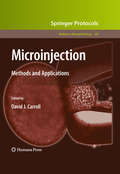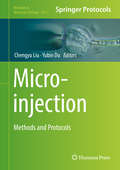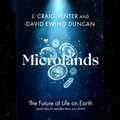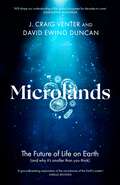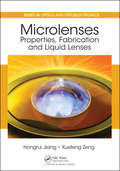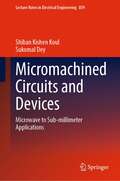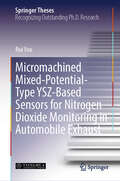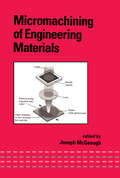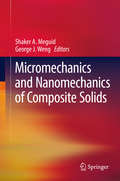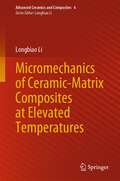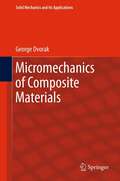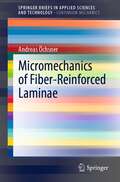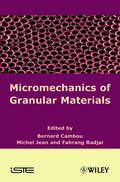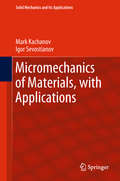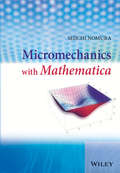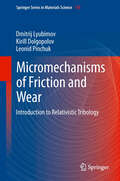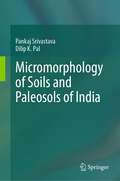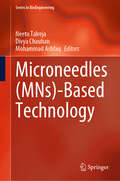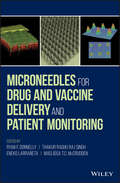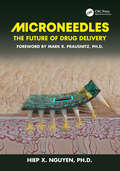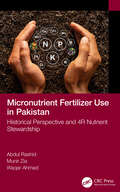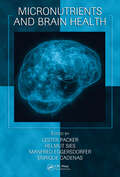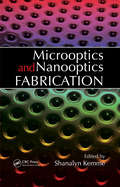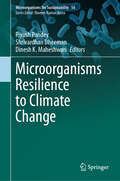- Table View
- List View
Microinjection
by David J. CarrollAs the number of sequenced genomes continues to increase, understanding the functions of newly discovered molecules will require greater efficiency and further study within the context of live cells. In Microinjection: Methods and Applications, expert researchers contribute methods utilizing microinjection techniques ranging from expression of RNA to the integration of DNA into the genome with the ultimate goal of learning about gene expression, signal transduction, and protein function within these living cells. This versatile volume updates established techniques such as cRNA expression in Xenopus oocytes, and examines new, cutting-edge technologies, including antisense morpholino oligonucleotides, RNAi for knockdown experiments, and the use of integrase to produce transgenic animals, all through microinjection techniques that can be easily adopted by any lab. Written in the highly successful Methods in Molecular BiologyTM series format, chapters include brief introductions to the topics, lists of the necessary materials and reagents, step-by-step, readily reproducible laboratory protocols, and Notes sections, highlighting tips on troubleshooting and avoiding known pitfalls. Comprehensive and easily accessible, Microinjection: Methods and Applications is an ideal source for new ideas and techniques certain to aid in the advance of biological research.
Microinjection: Methods And Protocols (Methods in Molecular Biology #1874)
by Chengyu Liu Yubin DuThis detailed book explores how microinjection will be used in the foreseeable future, not only for generating animal models for biomedical research but also for changing economically or ecologically important species that can broadly impact our society in general. The opening half of the book focuses on methods for generating mouse models, as they are still the most popular in genome engineering research, while the second half examines gene-editing in a variety of other species, opened up by the developments in ZFN, TALEN, and CRISPR techniques. Written for the highly successful Methods in Molecular Biology series, chapters include introductions to their respective topics, lists of the necessary materials and reagents, step-by-step, readily reproducible laboratory protocols, and tips on troubleshooting and avoiding known pitfalls. Authoritative and practical, Microinjection: Methods and Protocols serves as an ideal guide for researchers looking to take advantage of the breakthrough technologies in gene-editing and embryo micromanipulations.
Microlands: The Future of Life on Earth (and Why It’s Smaller Than You Think)
by David Ewing Duncan J. Craig Venter'An epic travelogue, brimming with the excitement of discovery. With characteristic panache, Venter unveils the teeming array of bacteria, viruses, and eukaryotes that crowd our planet's oceans' - Siddhartha Mukherjee'This page-turner gives . . . the thrill of seeing our planet's largest universe through the brilliant, intrepid eyes of the scientist who has done more than anyone to unlock the secrets of life' - Martine Rothblatt'A tour de force . . . Venter has expanded biology's horizons. This book explores microbial life on a global scale, providing cutting-edge solutions to problems of environmental change' - Aristides Patrinos'A ripping tale . . . to revolutionize our understanding of our bodies, the oceans, and the planet' - Jack Gilbert'An exhilarating account of how creative science is accomplished' - Sir Richard J. Roberts'[A] fascinating tour of Planet Microbe' - Bill McKibben'Venter and Duncan expand our scope of what it means to be alive' - Jamie Metzl'Inspiring ... change[s] our ideas of how biology is done' - TelegraphUpon completing his historic work on the Human Genome Project in 2002, J. Craig Venter declared that he would sequence the genetic code of all life on earth. Thus began a fifteen-year quest to collect DNA from the world's oldest and most abundant form of life: microbes. Boarding the Sorcerer II, a 100-foot sailboat turned research vessel, Venter travelled over 65,000 miles around the globe to sample ocean water and the microscopic life within.In this book, Venter and science writer David Ewing Duncan tell the remarkable story of these expeditions and of the momentous discoveries that ensued-of plant-like bacteria that get their energy from the sun, proteins that metabolize vast amounts of hydrogen, and microbes whose genes shield them from ultraviolet light. The result was a massive library of millions of unknown genes, thousands of unseen protein families, and new lineages of bacteria that revealed the unimaginable complexity of life on earth. Yet despite this exquisite diversity, Venter encountered sobering reminders of how human activity is disturbing the delicate microbial ecosystem that nurtures life on earth. In the face of unprecedented climate change, Venter and Duncan show how we can harness the microbial genome to develop alternative sources of energy, food, and medicine that might ultimately avert our destruction.A captivating story of exploration and discovery, this book restores microbes to their rightful place as crucial partners in our evolutionary past and guides to our future.
Microlands: The Future of Life on Earth (and Why It’s Smaller Than You Think)
by David Ewing Duncan J. Craig Venter'An epic travelogue, brimming with the excitement of discovery. With characteristic panache, Venter unveils the teeming array of bacteria, viruses, and eukaryotes that crowd our planet's oceans' - Siddhartha Mukherjee'This page-turner gives . . . the thrill of seeing our planet's largest universe through the brilliant, intrepid eyes of the scientist who has done more than anyone to unlock the secrets of life' - Martine Rothblatt'A tour de force . . . Venter has expanded biology's horizons. This book explores microbial life on a global scale, providing cutting-edge solutions to problems of environmental change' - Aristides Patrinos'A ripping tale . . . to revolutionize our understanding of our bodies, the oceans, and the planet' - Jack Gilbert'An exhilarating account of how creative science is accomplished' - Sir Richard J. Roberts'[A] fascinating tour of Planet Microbe' - Bill McKibben'Venter and Duncan expand our scope of what it means to be alive' - Jamie Metzl'Inspiring ... change[s] our ideas of how biology is done' - TelegraphUpon completing his historic work on the Human Genome Project in 2002, J. Craig Venter declared that he would sequence the genetic code of all life on earth. Thus began a fifteen-year quest to collect DNA from the world's oldest and most abundant form of life: microbes. Boarding the Sorcerer II, a 100-foot sailboat turned research vessel, Venter travelled over 65,000 miles around the globe to sample ocean water and the microscopic life within.In this book, Venter and science writer David Ewing Duncan tell the remarkable story of these expeditions and of the momentous discoveries that ensued-of plant-like bacteria that get their energy from the sun, proteins that metabolize vast amounts of hydrogen, and microbes whose genes shield them from ultraviolet light. The result was a massive library of millions of unknown genes, thousands of unseen protein families, and new lineages of bacteria that revealed the unimaginable complexity of life on earth. Yet despite this exquisite diversity, Venter encountered sobering reminders of how human activity is disturbing the delicate microbial ecosystem that nurtures life on earth. In the face of unprecedented climate change, Venter and Duncan show how we can harness the microbial genome to develop alternative sources of energy, food, and medicine that might ultimately avert our destruction.A captivating story of exploration and discovery, this book restores microbes to their rightful place as crucial partners in our evolutionary past and guides to our future.
Microlenses: Properties, Fabrication and Liquid Lenses (Series in Optics and Optoelectronics)
by Hongrui Jiang Xuefeng ZengDue to the development of microscale fabrication methods, microlenses are being used more and more in many unique applications, such as artificial implementations of compound eyes, optical communications, and labs-on-chips. Liquid microlenses, in particular, represent an important and growing research area yet there are no books devoted to this top
Micromachined Circuits and Devices: Microwave to Sub-millimeter Applications (Lecture Notes in Electrical Engineering #859)
by Shiban Kishen Koul Sukomal DeyThis book presents the design of different switching and resonant devices using the present state-of-the-art radio frequency (RF) micromachining (MEMS) technology. Different topologies of MEMS switches have been discussed considering optimum performances over microwave to millimeter wave frequency range. Wide varieties of micromachined switching networks starting from single-pole-double-throw (SPDT) to single-pole-fourteen-throw (SP14T) are discussed utilizing vertical and lateral actuation movements of the switch. Different transduction mechanisms of micromachined resonators are highlighted that includes capacitive, piezoelectric, and piezoresistive types. The book provides major design guidelines for the development of MEMS-based digital phase shifters, tunable filters, and antennas with extensive measurement data. Apart from the radio frequency (RF) requirements, an extensive guideline is given for the improvement of the reliability of micromachined switches and digital phase shifters where multiple switches are operating simultaneously. It takes multiple iterations and extensive characterizations to conclude with a reliable MEMS digital phase shifter, and these aspects are given one of the prime attentions in this book. Detailed performance analysis of metamaterial inspired MEMS switches is then discussed for application in millimeter wave frequency bands up to about 170 GHz. The book concludes with future research activities of RF MEMS technology and its potential in space, defense, sensors, and biomedical applications.
Micromachined Mixed-Potential-Type YSZ-Based Sensors for Nitrogen Dioxide Monitoring in Automobile Exhaust (Springer Theses)
by Rui YouThis book presents original methods to facilitate the development of micro-mixed-potential-type nitrogen dioxide sensors, especially in the following aspects: (i) improvement of sensing performance of electrodes; (ii) enhancement of chemical activity of reaction interface; (iii) development of advanced flexible low-power-consumption mixed-potential-type YSZ-based nitrogen dioxide sensors. Miniaturized sensors have steadily emerged into the commercial marketplace as competitive alternatives for monitoring and controlling the pollution gas in automobile industry. Despite the great potential, the real-world applications for most conventional micro-nitrogen dioxide sensors are still limited due to insufficient sensitivity, unacceptable cost, and the lack of robustness under harsh environmental disturbances. To address the issue, micro-nitrogen dioxide sensors based on mixed potential solid electrolyte is an ongoing area of great academic and technological interest. This book is expectedto be a guide for researchers on the way forward to chase future horizons in the fields of instrumentation, electrochemistry and micro/nano-electronics.
Micromachining of Engineering Materials (Mechanical Engineering)
by J.A. McGeoughExplaining principles underlying the main micromachining practices currently being used and developed in industrial countries around the world, Micromachining of Engineering Materials outlines advances in material removal that have led to micromachining, discusses procedures for precise measurement, includes molecular-level theories, describes vapo
Micromechanics and Nanomechanics of Composite Solids
by Shaker A. Meguid George J. WengThis book elucidates the most recent and highly original developments in the fields of micro- and nanomechanics and the corresponding homogenization techniques that can be reliably adopted and applied in determining the local properties, as well as the linear and nonlinear effective properties of the final architecture of these complex composite structures. Specifically, this volume, divided into three main sections--Fundamentals, Modeling, and Applications--provides recent developments in the mathematical framework of micro- and nanomechanics, including Green's function and Eshelby's inclusion problem, molecular mechanics, molecular dynamics, atomistic based continuum, multiscale modeling, and highly localized phenomena such as microcracks and plasticity. It is a compilation of the most recent efforts by a group of the world's most talented and respected researchers. Ideal for graduate students in aerospace, mechanical, civil, material science, life sciences, and biomedical engineering, researchers, practicing engineers, and consultants, the book provides a unified approach in compiling micro- and nano-scale phenomena. #65533; Elucidates recent and highly original developments in the fields of micromechanics and nanomechanics and the corresponding homogenization techniques; #65533; Includes several new topics that are not covered in the current literature, such as micromechanics of metamaterials, electrical conductivity of CNT and graphene nanocomposites, ferroelectrics, piezoelectric, and electromagnetic materials; #65533; Addresses highly localized phenomena such as coupled field problems, microcracks, inelasticity, dispersion of CNTs, synthesis, characterization and a number of interesting applications; #65533; Maximizes readers' ability to apply theories of micromechanics and nanomechanics to heterogeneous solids; #65533; Illustrates application of micro- and nanomechanical theory to design novel composite and nanocomposite materials.
Micromechanics of Ceramic-Matrix Composites at Elevated Temperatures (Advanced Ceramics and Composites #6)
by Longbiao LiCeramic-matrix composites (CMCs) possess high specific strength and modulus at elevated temperature, and have already been applied in hot-section components in aero-engines. To ensure the operation reliability and safety of CMCs components, it is necessary to understand the micro damage mechanisms and internal damage state in the composites. This book focuses on the micromechanics of CMCs at elevated temperatures, including, the stress-strain behavior, proportional limit stress, residual strength, mechanical hysteresis, interface damage, strain response, and lifetime of CMCs at elevated temperatures. This book can help the material scientists and engineering designers to better understand and master the micromechanics of CMCs at elevated temperatures.
Micromechanics of Composite Materials
by George DvorakThis book presents a broad exposition of analytical and numerical methods for modeling composite materials, laminates, polycrystals and other heterogeneous solids, with emphasis on connections between material properties and responses on several length scales, ranging from the nano and microscales to the macroscale. Many new results and methods developed by the author are incorporated into the rich fabric of the subject, which has developed from the work of many researchers over the last 50 years. Among the new results, the book offers an extensive analysis of internal and interface stresses caused by eigenstrains, such as thermal, transformation and inelastic strains in the constituents, which often exceed those caused by mechanical loads, and of inelastic behavior of metal matrix composites. Fiber prestress in laminates, and modeling of functionally graded materials are also analyzed. Furthermore, this book outlines several key subjects on modeling the properties of composites reinforced by particles of various shapes, aligned fibers, symmetric laminated plates and metal matrix composites. This volume is intended for advanced undergraduate and graduate students, researchers and engineers interested and involved in analysis and design of composite structures.
Micromechanics of Fiber-Reinforced Laminae (SpringerBriefs in Applied Sciences and Technology)
by Andreas ÖchsnerThis book provides an introduction to the micromechanics of fiber-reinforced laminae, which deals with the prediction of the macroscopic mechanical lamina properties based on the mechanical properties of the constituents, i.e., fibers and matrix. Composite materials, especially fiber-reinforced composites, are gaining increasing importance since they can overcome the limits of many structures based on classical metals. Particularly, the combination of a matrix with fibers provides far better properties than the components alone. Despite their importance, many engineering degree programs do not treat the mechanical behavior of this class of advanced structured materials in detail, at least on the Bachelor degree level. Thus, some engineers are not able to thoroughly apply and introduce these modern engineering materials in their design process. The focus is on unidirectional lamina which can be described based on orthotropic constitutive equations. Three classical approaches to predict the elastic properties, i.e., the mechanics of materials approach, the elasticity solutions with contiguity after Tsai, and the Halpin–Tsai relationships, are presented. The quality of each prediction is benchmarked based on two different sets of experimental values. The book concludes with optimized representations, which were obtained based on the least square approach for the used experimental data sets.
Micromechanics of Granular Materials
by Bernard Cambou Michel Jean Farhang RadjaïNearly all solids are compised of grains. However most studies treat materials as a continious solid. The book applies analysis used on loose granular materials to dense grainular materials. This title’s main focus is devoted to static or dynamic loadings applied to dense materials, although rapid flows and widely dispersed media are also mentioned briefly. Three essential areas are covered: Local variable analysis: Contact forces, displacements and rotations, orientation of contacting particles and fabric tensors are all examples of local variables. Their statistical distributions, such as spatial distribution and possible localization, are analyzed, taking into account experimental results or numerical simulations. Change of scales procedures: Also known as “homogenization techniques”, these procedures make it possible to construct continuum laws to be used in a continuum mechanics approach or performing smaller scale analyses. Numerical modeling: Several methods designed to calculate approximate solutions of dynamical equations together with unilateral contact and frictional laws are presented, including molecular dynamics, the distinct element method and non-smooth contact dynamics. Numerical examples are given and the quality of numerical approximations is discussed.
Micromechanics of Materials, with Applications (Solid Mechanics and Its Applications #249)
by Igor Sevostianov Mark KachanovThis book on micromechanics explores both traditional aspects and the advances made in the last 10–15 years. The viewpoint it assumes is that the rapidly developing field of micromechanics, apart from being of fundamental scientific importance, is motivated by materials science applications. The introductory chapter provides the necessary background together with some less traditional material, examining e.g. approximate elastic symmetries, Rice’s technique of internal variables and multipole expansions. The remainder of the book is divided into the following parts: (A) classic results, which consist of Rift Valley Energy (RVE), Hill’s results, Eshelby’s results for ellipsoidal inhomogeneities, and approximate schemes for the effective properties; (B) results aimed at overcoming these limitations, such as volumes smaller than RVE, quantitative characterization of “irregular” microstructures, non-ellipsoidal inhomogeneities, and cross-property connections; (C) local fields and effects of interactions on them; and lastly (D) – the largest section – which explores applications to eight classes of materials that illustrate how to apply the micromechanics methodology to specific materials.
Micromechanics with Mathematica
by Seiichi NomuraDemonstrates the simplicity and effectiveness of Mathematica as the solution to practical problems in composite materials. Designed for those who need to learn how micromechanical approaches can help understand the behaviour of bodies with voids, inclusions, defects, this book is perfect for readers without a programming background. Thoroughly introducing the concept of micromechanics, it helps readers assess the deformation of solids at a localized level and analyse a body with microstructures. The author approaches this analysis using the computer algebra system Mathematica, which facilitates complex index manipulations and mathematical expressions accurately. The book begins by covering the general topics of continuum mechanics such as coordinate transformations, kinematics, stress, constitutive relationship and material symmetry. Mathematica programming is also introduced with accompanying examples. In the second half of the book, an analysis of heterogeneous materials with emphasis on composites is covered. Takes a practical approach by using Mathematica, one of the most popular programmes for symbolic computation Introduces the concept of micromechanics with worked-out examples using Mathematica code for ease of understanding Logically begins with the essentials of the topic, such as kinematics and stress, before moving to more advanced areas Applications covered include the basics of continuum mechanics, Eshelby's method, analytical and semi-analytical approaches for materials with inclusions (composites) in both infinite and finite matrix media and thermal stresses for a medium with inclusions, all with Mathematica examples Features a problem and solution section on the book's companion website, useful for students new to the programme
Micromechanics with Mathematica
by Seiichi NomuraDemonstrates the simplicity and effectiveness of Mathematica as the solution to practical problems in composite materials. Designed for those who need to learn how micromechanical approaches can help understand the behaviour of bodies with voids, inclusions, defects, this book is perfect for readers without a programming background. Thoroughly introducing the concept of micromechanics, it helps readers assess the deformation of solids at a localized level and analyse a body with microstructures. The author approaches this analysis using the computer algebra system Mathematica, which facilitates complex index manipulations and mathematical expressions accurately. The book begins by covering the general topics of continuum mechanics such as coordinate transformations, kinematics, stress, constitutive relationship and material symmetry. Mathematica programming is also introduced with accompanying examples. In the second half of the book, an analysis of heterogeneous materials with emphasis on composites is covered. Takes a practical approach by using Mathematica, one of the most popular programmes for symbolic computation Introduces the concept of micromechanics with worked-out examples using Mathematica code for ease of understanding Logically begins with the essentials of the topic, such as kinematics and stress, before moving to more advanced areas Applications covered include the basics of continuum mechanics, Eshelby's method, analytical and semi-analytical approaches for materials with inclusions (composites) in both infinite and finite matrix media and thermal stresses for a medium with inclusions, all with Mathematica examples Features a problem and solution section on the book’s companion website, useful for students new to the programme
Micromechanisms of Friction and Wear
by Leonid Pinchuk Dmitrij Lyubimov Kirill DolgopolovThe modern vision of the micromechanism of friction and wear is explored, from the examination of ideal and real crystal structure and adhesion properties to the dynamics of solid frictional interaction. The fundamental quantum-mechanical and relativity principles of particle interaction are considered as basis of friction micro-process examination. The changes in solid structure originated from the influence of different kinds of force fields are considered. The principal possibility of relativity effect manifestation by friction is explained. The critical state of friction - triboplasma - was studied. Structural peculiarities of triboplasma, the kinetics of its transformation during frictional interaction as well as the influence of plasma and postplasma processes on tribojunction friction characteristics and complex formation by friction were examined. The book addresses to tribology researchers.
Micromorphology of Soils and Paleosols of India
by Pankaj Srivastava Dilip K. PalThis monograph covers uniqueness of micromorphology in resolving many important but enigmatic pedological issues such as clay illuviation, formation of pedogenic and non-pedogenic CaCO3, modification of plasmic fabric, contemporary and relict pedogenic processes, polygenesis of soils in Alfisols, Mollisols, Ultisols, Vertisols and Inceptisols of the tropical Indian environments. Chapters in this title also include identification of paleosols, diagenetic overprinting of the pedofeatures in lithified paleosols, and alluvial cyclicity of the fluvial successions. The techniques mentioned in this title are of tremendous value in pedological and geological research for precise and unambiguous definitions of soil taxa to build the national soil information and refine the stratigraphy of the terrestrial sediments. The information is for the benefit the students and researchers of pedology and geomorphology who often come across extreme difficulties in relating to examples applying the principles of soil formation from textbooks devoted almost exclusively to soils of the temperate climates. The format of this publication is arranged for a process-oriented text and figures on micromorphology of the tropical soils and paleosols as a reference for pedologists, earth scientists, M.Sc. and Ph.D. students, and also for land resource managers who are engaged in enhancing the productivity of such tropical soils in India and elsewhere.
Microneedles (Series in BioEngineering)
by Neetu Talreja Divya Chauhan Mohammad AshfaqThis book highlights the fabrication of various types of solid, hollow, and dissolvable microneedles (MNs) using various synthesis processes and their applications in medicine, agriculture, and sensors. MN-based technology emerges as a sign of hope, offering a painless delivery system. In general, MN-based technology uses tiny needles to puncture the outermost layer of the skin. MNs are made of various materials like metals, silicon, and polymers for efficient delivery of biomolecules. With the tremendous success of MNs in the drug delivery system, researchers try to use MNs in agriculture and sensor applications to improve plant health via monitoring and delivery of agrochemicals. By modulating the materials of MNs, drugs and biomolecules can be delivered in a controlled manner. In general, MN-based technology holds significant opportunities for improving delivery of the drugs/biomolecules and opens new wings toward agriculture and sensing applications. Moreover, MN-based technology enables newer avenues for therapeutic and diagnosis of diseases.
Microneedles for Drug and Vaccine Delivery and Patient Monitoring
by Ryan F. Donnelly Thakur Raghu Singh Eneko Larrañeta Maeliosa T.C. McCruddenProvides comprehensive coverage of microneedles for delivering and monitoring patient drugs and vaccines Microneedles are an incredibly active research area and have the potential to revolutionize the way many medicines and vaccines are delivered. This comprehensive research book covers the major aspects relating to the use of microneedle arrays in enhancing both transdermal and intradermal drug delivery and provides a sound background to the use of microneedle arrays in enhanced delivery applications. Beginning with a history of the field and the various methods employed to produce microneedles from different materials, Microneedles for Drug and Vaccine Delivery and Patient Monitoring discusses the penetration of the stratum corneum by microneedles and the importance of application method and force and microneedle geometry (height, shape, inter-needle spacing). Transdermal and intradermal delivery research using microneedles is comprehensively and critically reviewed, focusing on the outcomes of in vivo animal and human studies. The book describes the important topics of safety and patient acceptability studies carried out to date. It also covers in detail the growing area for microneedle use in the monitoring of interstitial fluid contents. Finally, it reviews translational and regulatory developments in the microneedles field and describes the work ongoing in industry. The only book currently available on microneedles Filled with tables, graphs, and black and white images (photographs, micrographs) Authored by four experts in pharmaceutics Microneedles for Drug and Vaccine Delivery and Patient Monitoring is an ideal source for researchers in industry and academia working on drug delivery and transdermal delivery in particular, as well as for advanced students in pharmacy and pharmaceutical sciences.
Microneedles: The Future of Drug Delivery
by Hiep Xuan NguyenThe microneedle field has been expanding exponentially with innovative designs and various applications, thus capturing the interest of academic industry and regulatory sectors. Microneedles: The Future of Drug Delivery equips readers with a comprehensive understanding of microneedles: from percutaneous absorption to microneedles production, characterization, applications in drug delivery and diagnosis, to practical perspectives on the development, manufacturing, regulatory issues, and commercialization of microneedles. This book is written by a single author and thus provides complex information in a simple, elegant, and cohesive style. The book is intended for graduate students, researchers, scientists, and engineers working in the pharmaceutical, medical, cosmeceutical, and biotechnology industry.
Micronutrient Fertilizer Use in Pakistan: Historical Perspective and 4R Nutrient Stewardship
by Waqar Ahmad Abdul Rashid Munir ZiaMicronutrient research has been an important component of the soil fertility and plant nutrition program in Pakistan since the identification of zinc deficiency in rice in 1969. Since then, considerable progress has been made on diagnosis and management of micronutrient nutrition problems in crops. However, now there is growing R&D evidence that micronutrient malnutrition in humans could be addressed through enriching staple food grains with micronutrients. This book presents the latest R&D information on micronutrient problems in crop plants/cropping systems and their corrective measures. The current status, the constraints, and economic benefits of using micronutrient fertilizers for optimizing crop productivity and soil resource sustainability are discussed along with estimating future potential requirement of micronutrient fertilizers to optimize crop productivity, produce quality, and soil resource sustainability. Wide-scale preventable micronutrient deficiencies in human populations originate from micronutrient-deficient soils over which staple cereals and other food crops are grown. This book summarizes R&D information on fertilizer use-based micronutrient biofortification in staple food grains to address "hidden hunger" in human populations. The book also presents the best management practices by which micronutrient deficiencies could be corrected in crop plants in a farmer-friendly manner. Features Reviews the micronutrients R&D carried out in Pakistan over the past five decades Focuses on soil–plant analysis techniques for effective prognosis and diagnosis of micronutrient disorders Presents spatial variability maps of micronutrient deficiencies in agricultural soils and crops Provides value–cost ratios of using micronutrient fertilizers for major crops Works out current use level of micronutrient fertilizers and their potential future requirements in the country Discusses agronomic biofortification approach for enriching crop-based food with micronutrients to address "hidden hunger" Presents a compelling case for enhanced use of the deficient micronutrient fertilizers to optimize crop productivity, farmer income, and national economy Presents micronutrient fertilizer use recommendations for salient crops and discusses fertilizer use for micronutrients in the context of 4R nutrient stewardship Recommends future R&D needed for optimizing micronutrient nutrition of crops
Micronutrients and Brain Health (Oxidative Stress and Disease)
by Manfred Eggersdorfer Helmut Sies Enrique Cadenas Lester PackerMicronutrients and Brain Health addresses cutting-edge research related to processes of oxidative stress that affect brain function, an area of increasing significance for those concerned and involved with public health and translational medicine. Edited by four leading micronutrient researchers, the book brings together the investigative work of m
Microoptics and Nanooptics Fabrication
by Shanalyn A. KemmeThe deep interconnection between micro/nanooptical components and related fabrication technologies—and the constant changes in this ever-evolving field—means that successful design depends on the engineer’s ability to accommodate cutting-edge theoretical developments in fabrication techniques and experimental realization.Documenting the state of the art in fabrication processes, Microoptics and Nanooptics Fabrication provides an up-to-date synopsis of recent breakthroughs in micro- and nanooptics that improve key developmental processes. This text elucidates the precise and miniaturized scale of today’s fabrication methods and their importance in creating new optical components to access the spectrum of physical optics. It details successful fabrication techniques and their direct effect on the intended performance of micro- and nanooptical components. The contributors explore the constraints related to material selection, component lateral extent, minimum feature size, and other issues that cause fabrication techniques to lag behind corresponding theory in the development process. Written with the professional optical engineer in mind, this book omits the already well-published broader processing fundamentals. Instead it focuses on key tricks of the trade helpful in reformulating processes to achieve necessary optical targets, improve process fidelity, and reduce production costs. The contributing authors represent the vanguard in micro-optical fabrication. The result of their combined efforts, this searing analysis of emerging fabrication technologies will continue to fuel the expansion of optics components, from the microwave to the infrared through the visible regime.
Microorganisms Resilience to Climate Change (Microorganisms for Sustainability #56)
by Dinesh K. Maheshwari Piyush Pandey Shrivardhan DheemanThis book covers a wide range of topics such as role of microorganisms in the global carbon cycle, the impact of climate change on microbial communities, and the feedback mechanism between them. Microorganisms produce and consume greenhouse gases to transform essential elements, such as carbon and nitrogen, to form their cellular components. Microorganisms are also involved in nitrogen and phosphorus cycling, which are essential for plant growth and productivity. Thus, the role of microbial communities in agroecosystems with biogeochemical cycles is imperative for addressing the current global warming situation. Microorganisms are highly sensitive to changes in environmental conditions such as temperature, moisture, and nutrient availability. As the climate continues to change, shifts in microbial community structure and function may have significant consequences for ecosystem services such as nutrient cycling, water purification, and carbon sequestration. In this book experts from a range of fields, such as microbiology, ecology, biogeochemistry, and climate science come together to provide a holistic perspective on the role of microorganisms in climate change. This book is of reference to policymakers, educators, researchers and students working in the field of microbiology and climate sciences.
